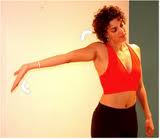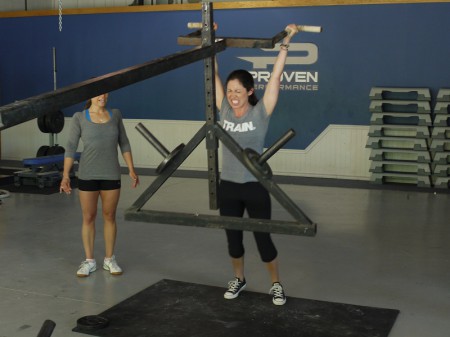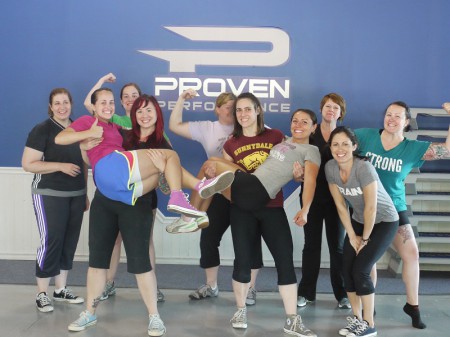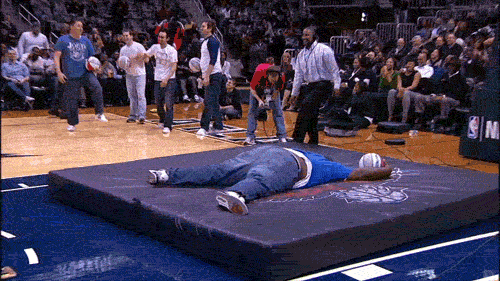The human body is incredibly complicated. I’ve been through various anatomy, physiology, and biomechanics classes that have given me an appreciation of the body, but being able to study on cadavers was life changing. It was amazing to hold a human heart in my hands knowing that it belonged to a living, breathing person who had hopes, dreams, aspirations, a family, children…a life. To hold that person’s heart, one of the most important organs yet a symbol of vitality and love, was something I’ll never forget.
More to the point, the musculoskeletal system was fascinating. Instead of looking at bones or models of bones and muscles, I could see them right in front of me. The rectus femoris attaches on the anterior inferior iliac spine and travels down to integrate with the other three parts of the quadriceps to a common tendon that attach to the patella, which shifts into a ligament that attaches on the tibial tuberosity on the anterior side of the proximal tibia. God damn it, isn’t it beautiful? Seeing it gave me an immense appreciation for the complexity of life and how it evolved to be that way.
I love and appreciate this kind of shit, and I love and appreciate teaching people to optimally train their bodies to perform and be as healthy as possible. There’s a lot going on when we train, eat, sleep, or experience life. It takes effort to keep things on track, yet there’s a lot that can easily go wrong. I’m often surprised that some people have made it as far as they have; the crack addict still breathes years after being addicted and the ignorant guy who deadlifts with a horribly flexed lumbar still hasn’t blown out a disc. Humans are a hardy species.
I have two friends that have had nerve issues to the point that it has effected their training. Shawn has made his way through law school and still manages to train about four times a week. “Mace” is a soldier who has been blown up and shot. They have very different backgrounds and different nerve related issues that they have either fixed or improved.
I want to point out that I’m not a medical doctor. I’ve had several medical doctors comment that I know anatomy better than they do, but I think they were just being nice. Anything I say should not be taken for medical advice; when in doubt, go see a doctor. But let’s face it, some times we — people who train regularly — do not have the resources to see a doctor. Does this mean you should try adjusting your vertebral segments on your own? Absolutely not. But there are ways that you can work on your body to improve your ailments (it’s the premise behind MobilityWOD). Most of us can handle the minor repairs in our house; it’s only when there is a major issue (a flooded basement, the hot water heater craps out, etc.) that we’ll get ‘professional help’. Our bodies should be no different. Let’s look at how we addressed some nerve related issues.
Shawn
Earlier this year Shawn started noticing that his left hand was feeling numb. Specifically it was his pinky finger and half of his ring finger. When he pressed, he noticed that his wrist felt extremely unstable, especially at the top half of the range of motion. He felt as if he had no sensory feedback, kind of like when your foot falls asleep. Shawn can deadlift close to 405, but when he was doing 315 one day it felt hard, and the bar just fell out of his hand halfway up. He realized something was wrong and had it looked at. He was told he had carpal tunnel.
To me, that’s a bullshit over simplification. The pinky and ring finger are precisely where the ulnar nerve travels to. That tells me there is something occluding or impinging his ulnar nerve, but the question is where? After being told he had carpal tunnel, Shawn was conscious of his wrist position when typing (he was working at a law firm while finishing his degree), yet the issue never went away. That told me it didn’t have much to do with the wrist.
I started thinking about three other places: the elbow, shoulder and neck. If someone is particularly tight in their internal rotators of the shoulder, I could see that pinching down on the brachial plexus and causing issues, but I’d sort of expect there to be some shoulder or inner biceps pain. There wasn’t really any of that, but file that info away. I started asking Shawn about what his elbow was doing when he is sitting. He primarily sits in class, at work, in his truck commuting, or at his desk at home. It turns out that his medial elbow was often mashed down on the arm rest of his chairs or the door of his truck (you know, the “I’m a big guy and my elbow is sticking out my window” style of driving a truck).
I collected all of this data and created a non-invasive prescription for Shawn.
1. Stop sitting with the medial elbow in contact with surfaces.
2. Complete nerve flossing 4x/day (more on this below).
3. Stretch the internal rotators of the shoulder and tie in the neck 2x/day.
By not impinging the nerve, we should free up that medial elbow and allow the nerve signal to pass through the area. By stretching the shoulder and neck, we could account for any possible tightness in the area that could impinge on cervical or brachial nerves. Lastly, the nerve flossing seems to be significant in treating the issue. To perform it, a person would reach their arm out laterally from their side so that their whole arm is horizontal. The palm is up, which supinates the forearm and slightly externally rotates the shoulder. They then look forward with good spinal posture and gently laterally flex their neck away from the outstretched arm. They would hold for a count, and then return their head to neutral position.

Kinda like this, but keep the wrist straight and laterally flex the head away from the arm. Click picture for source.
Within a week or so, Shawn noticed improvement in his numb fingers. His wrist felt more stable when training, and his grip strength returned. His fingers became sensitive to regular temperatures of water; they would feel like extreme hot or cold on the pinky and half of ring finger while the rest of the hand felt a moderate temperature. My guess is that because his fingers had lost innervation for several weeks, his body adapted to not feeling anything. When the neural innervation returned, his sensitivity was heightened to the temperatures. Now, several months later Shawn doesn’t have any issues with his fingers or wrist.
“Mace”
This guy is a crazy asshole in the Army who has made a really solid effort on getting killed in or out of combat. When his humvee was blown up by an IED, it started a series of issues that eventually resulted in two herniated discs in his back that cause localized and sciatic pain. When he was trying to jump off of a building to avoid an RPG, the explosion took his feet out from under him and he dislocated his left shoulder and tore his labrum. At least the grazing AK round on his leg didn’t leave any lingering damage.
Mace’s issue is in his right shoulder. He noticed that his right deltoid was just not being innervated, and this resulted in a lop-sided press. “Brute force and ignorance” didn’t seem to help, so we started collecting info on his situation. Unlike Shawn, who had no history of cervical injury, Mace probably has some kind of cervical issue that could be causing this. He could have a brachial plexus issue. Who knows? He’d have to wait to wait a bit to see a military doc, so I figured we might as well try:
1. Nerve flossing, same thing as what Shawn did.
2. Working on shoulder mobility, especially internal rotation stuff.
Before trying this treatment, Mace’s deltoid simply wouldn’t innervate properly (he sent me a video, it’s weird). He found that if he did the neural flossing at home, it would help innervate his deltoid and he’d get a decent press workout. He found that if he did it as part of his warm-up at the gym that he would still favor his right shoulder. Regardless, he still does it at the end of his training session. Despite our efforts that improved the issue slightly, his “shit is still fucked up”. He will see a neurologist soon and hopefully they can shed some light on where his issue originates and whether or not he can do basic treatments to keep him operational.
Recap
Nerve issues are not incredibly common in the training world. Hopefully this post gives you two perspectives. In Shawn’s case, we were able to identify what caused his issue, created an effective rehab program, and completely eradicated the problem. In Mace’s case, he has some more serious stuff going on that is going to require actual medical attention. We can discern the difference through collecting data on our “patients”. I was quickly able to identify what was probably causing Shawn’s problem by critically thinking with anatomical knowledge. I knew Mace’s issue was going to require “proper medical attention” since there wasn’t really one cause we could point to, but I still thought we could improve it to some degree (we did).
In either case, the assessment and “prescription” were derived from a knowledge of anatomy and physiology. I’ve explained in the past why anatomy is important for people who coach or train, but took it to a different level here. Coaches, trainers, or “fitness professionals” owe it to their clients to continuously learn about the human body. That doesn’t mean they should have to take bullshit continuing education credits on stupid pieces of equipment, coaching, or nutrition, but should focus on the hard sciences applied to relevant scenarios. I didn’t do anything special here; PT’s or chiros may have better solutions. Yet I was able to eliminate or improve serious problems that hampered two friends’ training.
And it all starts with anatomy and physiology.











